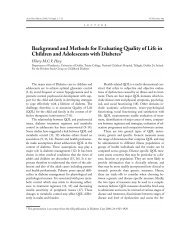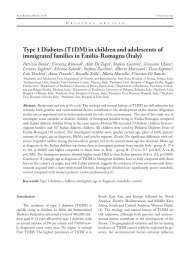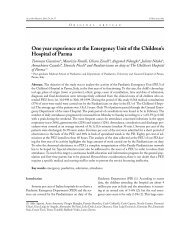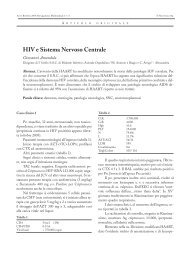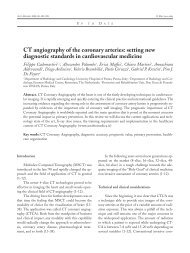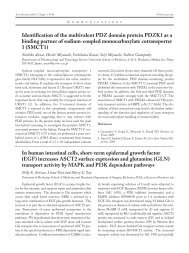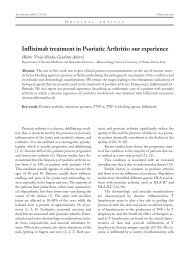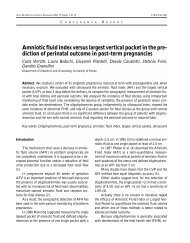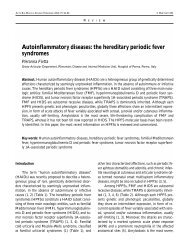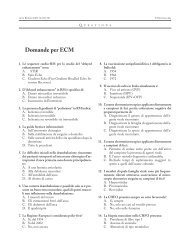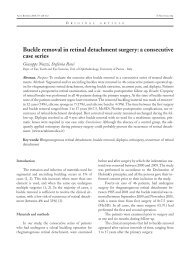Short reports+frontesp96-98 - Acta Bio Medica Atenei Parmensis
Short reports+frontesp96-98 - Acta Bio Medica Atenei Parmensis
Short reports+frontesp96-98 - Acta Bio Medica Atenei Parmensis
Create successful ePaper yourself
Turn your PDF publications into a flip-book with our unique Google optimized e-Paper software.
<strong>Short</strong> Reports<br />
103<br />
to convert only 16 laparoscopic cholecystectomy to<br />
open, 8 during the early (20%) and 8 during the delayed<br />
(29%). The mean time of hospitalization was of<br />
7.6 days for early approach and 11.6 for the delayed<br />
one. There was no higher rate of complications<br />
between the two different surgical timings. Conclusions:<br />
Our experience is important to show that early<br />
laparoscopic approach is feasible because the conversion<br />
rate and the post-operative morbidity are no higher<br />
than delayed laparoscopy or open approach after<br />
medical management. Total hospitalisation is significantly<br />
shorter and we avoid the complications which<br />
may arise with initial medical management so we<br />
should consider early laparoscopic cholecystectomy as<br />
the gold standard.<br />
Male breast cancer: our experience<br />
G. Di Martino, D.P. Calabrese, A. Farina, M. Lamberti,<br />
E. Palma, G. Limite<br />
Department of General, Oncology and Videoassisted Surgery,<br />
University of Naples Federico II, Naples, Italy<br />
Breast cancer in males is infrequent, accounting<br />
for less than 1% of all malignancies diagnosed in men<br />
(1). As a consequence of the relative rarity of the disease,<br />
less information are available regarding optimal<br />
management and outcomes. Data were collected<br />
about ten men presented and treated at our unit for<br />
breast cancer from January 1992 to December 2002.<br />
Mean age at presentation was 62.5 years. The mode of<br />
presentation was often a painless palpable mass. Treatment<br />
consisted of 7 modified radical mastectomies<br />
and 3 simple mastectomies. Histological examination<br />
on surgical specimens revealed 7 infiltrating ductal<br />
carcinomas, 2 in situ ductal carcinomas and a mucinous<br />
breast cancer. Lymph node involvement was seen<br />
in one patient. 20% of patients were classified as stage<br />
0, 40% stage I, 20% stage IIA and 20% stage III B. Tumors<br />
presented mainly with high espression for estrogen<br />
and progesterone receptors. Adiuvant systemic<br />
chemotherapy and/or antiestrogen therapy in the<br />
form of tamoxifen were the treatment most frequently<br />
used. Nevertheless, a patient developed a new cancer<br />
in the opposite breast three years after surgery and was<br />
treated with radical modified mastectomy and adjuvant<br />
therapy. One patient died for breast cancer, while<br />
another died for comorbid disease.Male breast carcinoma<br />
presents with an older age and a more advanced<br />
stage of disease than do women. However, breast<br />
carcinoma in men is not biologically more aggressive<br />
than in females. Axillary lymph node involvement remains<br />
the most important prognostic factor. Probably,<br />
the overall survival find in this group is related to the<br />
number of in- situ carcinomas and also the nodal status<br />
(N0). Our experience, according to literature (2, 3)<br />
suggests that the prognosis of breast cancer in men is<br />
comparable to that of women of the same age and stage<br />
of disease at diagnosis and treatment is not much<br />
different between two sexes.<br />
References<br />
1. Parker SL, Tong T, Bolden S, Wingo PA. Cancer statistics.<br />
Cancer J Clin 1997; 47: 5-27.<br />
2. Willsher PC, Leach IH, Ellis IO, Bourke JB, Robertson JF.<br />
A comparison of outcome of male breast cancer with female<br />
breast cancer. Am J Surg 1997; 173; 185-88.<br />
3. Donegan WL, Redlich PN, Lang PJ, Gall MT. Carcinoma<br />
of the breast in males: a multi institutional survey. Cancer<br />
19<strong>98</strong>; 83: 4<strong>98</strong>-509.<br />
Surgical treatment for pancreatic cancer<br />
M. Di Martino, V. Maffettone, P. Limongelli, G.M. del<br />
Genio, I. Fiume, F. Pizza, C. Di Stazio, P. Picarella, S.<br />
Tolone, A. del Genio<br />
I Division of General and Gastroenterologic Surgery, II University<br />
of Naples, Naples, Italy<br />
Aims: This study evaluates the impact of different<br />
treatments on survival in patients with advanced pancreatic<br />
cancer treated from 1995 to 2004. Materials<br />
and methods: Data on 51 patients (30 men, 21 women),<br />
mean age 60.3 years, were analysed retrospectively.<br />
We included co-morbidities, symptoms, tumor<br />
markers, tumor characteristics, operative data and late<br />
outcome. Results: In 31 patients pancreatic tumor interested<br />
the head, in 4 patients the ampoule, in 7<br />
body-tail, in 9 extensively the gland. Final diagnoses<br />
showed 58.9% ductal adenocarcinoma, 13.7% mucinous<br />
cystadenoma, 13.7% serous cystadenoma, 3.9%<br />
insulinoma, 9.8% unspecified forms. The right site lesions<br />
were less differentiated. The median tumor size



